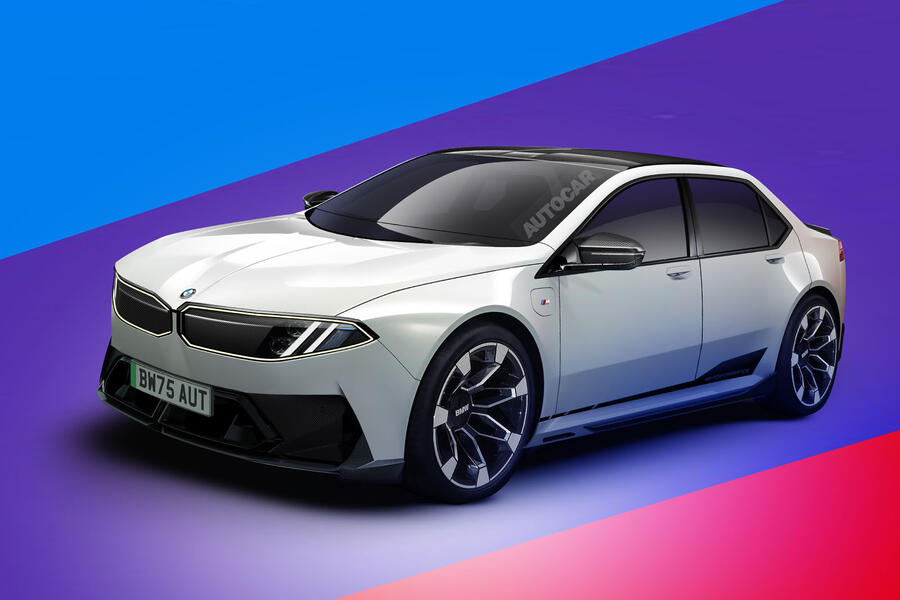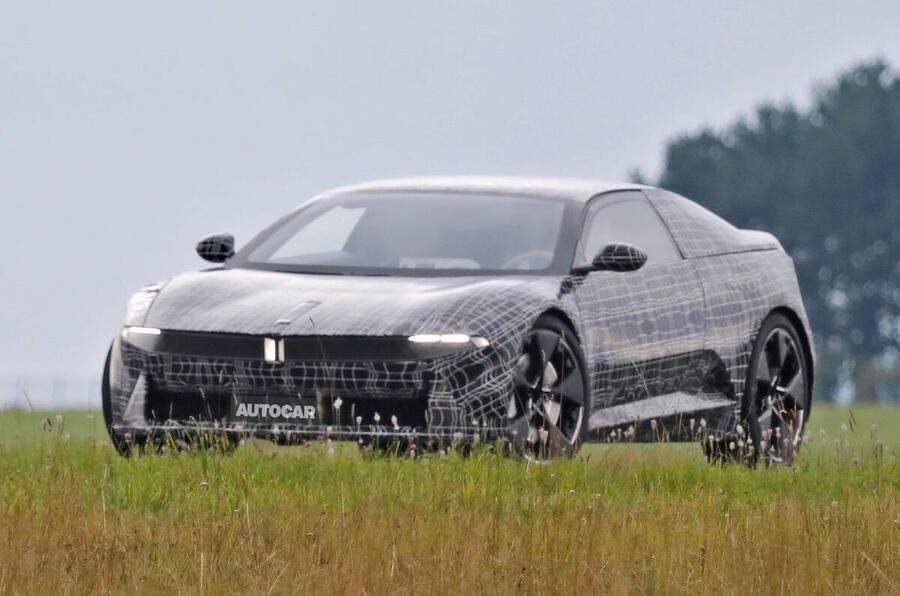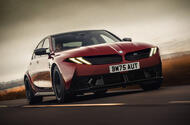Combustion-engined M3 will draw heavily on today’s car, but with styling influence from the Neue Klasse
BMW’s sports saloon lineage to diverge as Neue Klasse EVs arrive
The BMW M3 will return for a seventh generation with the choice of either a straight-six turbo petrol engine or a high-tech EV powertrain with huge power and unprecedented dynamic ability.
Due by early 2028, the next M3 is being engineered for both powertrains in a bid to maximise its appeal and in line with BMW’s ongoing commitment to combustion power. The current car’s ‘S58’ twin-turbo 3.0-litre straight six has been made compliant with upcoming emissions regulations, meaning the petrol M3 can – for as long as customer demand dictates – remain on sale alongside the all-new electric version, which will be based on BMW’s Neue Klasse platform.
In a wide-reaching interview with Autocar, BMW M CEO Frank van Meel has laid bare his priorities and plans for the electrification of the storied performance division. At the centre of those plans is the new generation of its seminal sports saloon – overhauled from the ground up to take the fight to EV and ICE rivals including the Mercedes-AMG C63, Porsche Taycan and Hyundai Ioniq 5 N.
Asked if the electric and ICE M3s will wear different badges, van Meel said: “Do we need to set them apart? An M3 is a promise, not an engine.” That strongly suggests that electric car will not adopt the iM3 moniker, despite BMW having trademarked it.
The EV version will be derived from the next-generation 3 Series, due on sale from next year, while the ICE car is likely to be a heavily updated version of today’s ‘G80’ M3, with Neue Klasse design influence.
“We’re also working on the newest emission regulations on combustion engines. We’re planning to keep up our combustion cars as well,” said van Meel, who is adamant that the M3 will retain its signature pace and dynamic agility, irrespective of powertrain.
He conceded that the first generation of BMW’s electric performance cars will be heavier than their combustion forebears, because customers want their EVs to have a usable range and that – until solid-state packs arrive – means big, weighty batteries.
However, he suggested that with the proliferation of public EV chargers comes the ability to install smaller battery packs and thus reduce weight – important for sports cars, particularly.
“It’s the hen and egg principle,” he told Autocar.
“The way I see it in the end is it’s going to be all-electric. Once you can make high-performance cars – and we will in the future – all-electric, then the next question is what about charging infrastructure.
“That is the key question and it’s not a question that a car manufacturer can answer. So in the beginning, the cars will be heavy because they will be equipped with batteries that allow a long range to avoid range anxiety in environments where charging infrastructure is still not widely spread.”

As an indication of what an electric BMW super-saloon might weigh, the closest thing to a full-fat M EV currently on sale is the top-rung i5 M60 xDrive which is a heady 2.3 tonnes, compared with 1930kg for the previous-generation, pure-petrol M5.
Van Meel likened this phenomenon to the rise of the iPhone: “When it came out, you just wanted to throw away your old phone. I had a Nokia 6210, the classic one. It had a standby time of 84 hours. Then the iPhone came and didn’t have a standby time of 12 hours. It could do huge things, but actually I went to the Geneva motor show and by 12.30 I ran out of battery. I couldn’t call anyone!”
He added: “But the batteries became better, everyone has a charging cable, in every hotel and car there is a plug… so now you’re used to it. You can plug it in everywhere and it’s no hassle any more.”
The M division’s priority in the medium term, then, is to ensure its EVs remain as agile and engaging as its current cars in spite of the inevitable extra bulk.
Van Meel says the new M5 – now a plug-in hybrid that weighs around half a tonne more than its pure-V8 predecessor – illustrates how the division will use innovative power management technology to mitigate the impact of this added weight.
He recalls that when the sports saloon went four-wheel drive for its previous generation, there was concern about what that would mean for the model’s trademark rear-biased handling balance, but he had been impressed by prototypes and was confident in the car’s dynamic credentials. He said: “I already knew how it was going to drive, but I couldn’t tell anyone or explain, so I had to just wait until the car came out and everyone could drive it, and then it was fine. And now it’s the best M5 ever…”
Van Meel said he feels the same now, having spent time at the wheel of test mules for electric M cars: “I’ve driven our cars and I know what we’re doing, and they’re really cool – but either I don’t want to say right now what we’re doing, or I can’t transfer the message because you come from what you know, and you don’t know what we’re doing.”
Crucial to appeasing the keen driver will be the new quad-motor powertrain arrangement that M engineers are testing in prototypes. This allows for full four-wheel torque vectoring that means “you can have a perfect line and the precision you know from an M car”.
But, van Meel added, “to get the precision, it does not help only to have four electric motors: you need a central control unit and that’s what we used to call the Hand of God.” This is the central computer BMW M cars use to vary power delivery to each wheel and it has been renamed the Heart of Joy for its electric performance cars.
“It seems more complicated, but it’s also more interesting if you control them with one ‘hand’ – not only in regards to accelerating or cornering but also braking and stabilising,” he said. “Then you have the possibility to create a new dimension of vehicle dynamics, and then you can counteract the increase in weight.”
His comments echo those of Alpine CEO Philippe Krief, who has said torque vectoring between multiple electric motors can create a feeling of “perceived lightness” that masks the true weight of an EV.
Importantly, each major component in a BMW M electric drivetrain will be bespoke to the sporting division. Much as it has always used heavily reworked versions of standard BMW engines, it will continue to use parts from its parent company as the basis for higher-output, performance-focused electric systems.
Van Meel said: “In the past, we had special engines like the S58. BMW had a B58 and we took the base engine, made modifications – new cylinder head, new production processes – and we can assemble it on the lines where the B58 engine is assembled, and the same was true with the S63 and N63 V8 engines.
“We use the same ideas and logic for developing our high-performance engines. We are in close cooperation with BMW AG to use their bases as a basis for what we are making at M.”
BMW’s red herring prototype exposed

Recent spy shots of a rakish, camouflaged BMW prototype sparked speculation that the M division’s first EV would be an angular sports coupé in the vein of the original M1, albeit higher-riding and with a bulkier body shell – but boss Frank van Meel poured cold water on the notion of that car reaching production with an M badge.
The test mule has a motor at each corner, as per M’s modus operandi for electric sports cars, but here they are mounted in the wheels themselves, a solution that won’t work for the highest-output powertrains under development in Munich.
“You’re talking about hundreds of kilowatts,” said van Meel. “You can’t cool that with air.”
This headline-grabbing prototype is most likely to evolve into a fully functioning showcase of BMW’s future design cues and technological priorities as it ushers in a completely new generation of EVs from next year, beginning with replacements for the X3 and 3 Series.
While it’s unclear who supplied the motors for this mule, British firm Protean Electric has used a Land Rover Defender EV prototype to demonstrate that placing motors in the wheels can do away with axles, driveshafts and subframes. This in turn reduces mass and therefore cost, because smaller batteries can be fitted and packaged in such a way that needn’t make the EV so tall.
Source: Autocar RSS Feed

